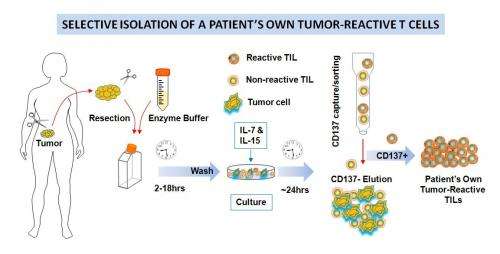Finding antitumor T cells in a patient's own cancer

Patients with tumors that contain increased numbers of T lymphocytes generally survive longer than those with tumors without T-cell involvement, suggesting that T cells with potent antitumor function naturally exist in cancer and control tumor progression. With the exception of melanoma, it has been difficult to identify and isolate the tumor-reactive T cells from common cancers, however, the ability to do so could be used to fight a patient's own cancer.
In a paper recently published in Clinical Cancer Research, investigators in the lab of Daniel Powell, PhD, at the Perelman School of Medicine, University of Pennsylvania, demonstrated for the first time that a T cell activation molecule can be used as a biomarker to identify rare antitumor T cells in human cancers. The molecule, CD137, is a protein that is not normally found on the surface of resting T cells but its expression is induced when the T cell is activated.
In their work, Powell and colleagues developed a rapid system to accurately isolate these cells directly from human tumor tissue. TILs, short for tumor-infiltrating lymphocytes – are white blood cells that have left the bloodstream and migrated into tumor tissue. They took human tumor samples that contained TILs, disrupted them to single cell suspensions, and cultured the mix of tumor cells and TILs overnight. The next morning they selectively captured the TILs that expressed the CD137 molecule.
In a test tube-based experiment, the team showed that the isolated CD137 T cells recognize cancers cells taken from the same patient. The T cells recognize proteins (called antigens, immunologically) presented by the tumor cells as small peptides derived from inside the cell.
After isolating the CD137 cells from other non-reactive TILs and tumor cells, they theoretically could be given back to the patient as a concentrated dose of their own tumor-fighting cells. To model this, the team injected cancer cells in combination with the CD137 TILs into immune-deficient mice. The CD137 TILs actively controlled tumor progression, while TILs that did not express CD137 from the same patient had no impact on tumor growth.
Giving large numbers of patients' tumor-reactive T cells back to the same patient can lead to cancer eradication in melanoma, but investigators have had a hard time doing the same for other cancers. However, Powell and colleagues showed that their new approach can be used in a variety of cancers, including melanoma and ovarian cancer, which suggests this promising therapy can now be widely applied.
This field has a growing enthusiasm for T-cell therapy, says Powell. The initial findings are encouraging and have produced additional questions to be answered: How do CD137 cells control tumor growth? In what other cancers do similar tumor-reactive T cells exist? How can we identify, expand, and use them? How can we use this new knowledge to shorten the time to make TILs for clinical trials? Powell and colleagues are working diligently to address these questions and move the current approach forward.
More information: clincancerres.aacrjournals.org … 3-0945.full.pdf+html













